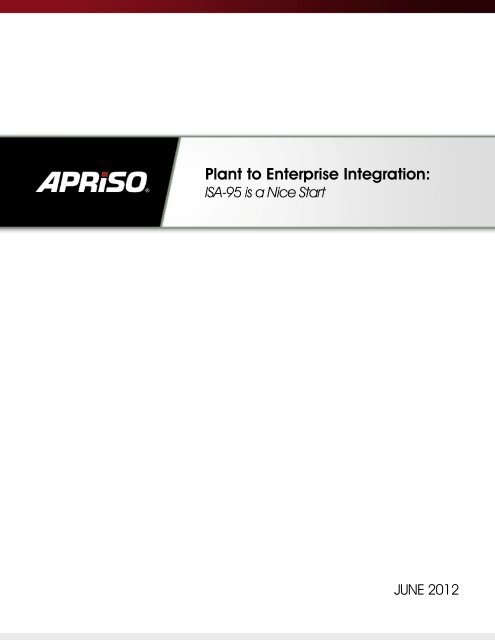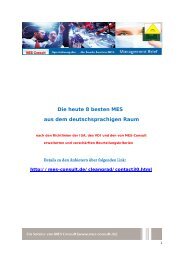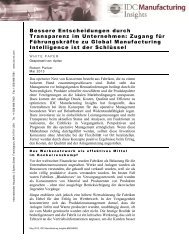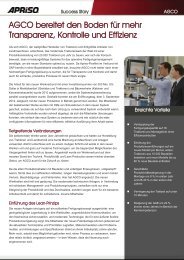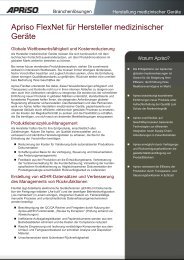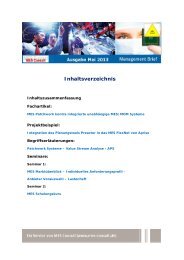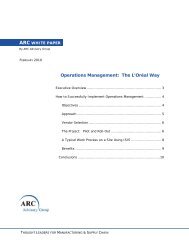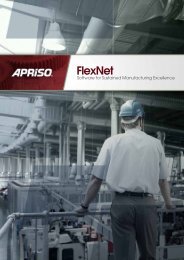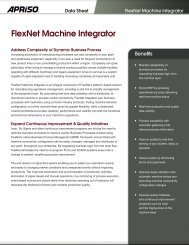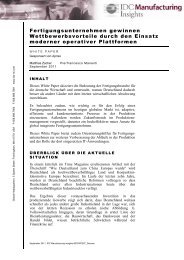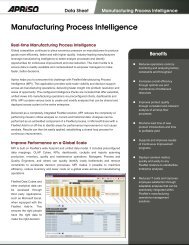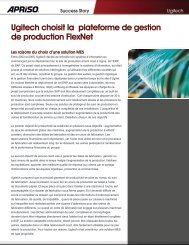ISA-95 is a Nice Start - Apriso
ISA-95 is a Nice Start - Apriso
ISA-95 is a Nice Start - Apriso
Create successful ePaper yourself
Turn your PDF publications into a flip-book with our unique Google optimized e-Paper software.
Plant to Enterpr<strong>is</strong>e Integration:<br />
<strong>ISA</strong>-<strong>95</strong> <strong>is</strong> a <strong>Nice</strong> <strong>Start</strong><br />
JUNE 2012
Table of Contents<br />
Executive Summary ....................................................................................... 3<br />
The Need for Enterpr<strong>is</strong>e Integration to Plant Operations ................................ 4<br />
<strong>ISA</strong>-<strong>95</strong>: An Integration Standard ................................................................... 6<br />
What you Need to Know about <strong>ISA</strong>-<strong>95</strong> ........................................................... 7<br />
What <strong>ISA</strong>-<strong>95</strong> Got Right .................................................................................. 8<br />
Identifies a Need for Data Flow ................................................................................. 8<br />
Multi-Department Communication ............................................................................. 8<br />
Implementation Project Guidance ............................................................................. 8<br />
Where <strong>ISA</strong>-<strong>95</strong> Could be Better ....................................................................... 8<br />
Process Manufacturing Bias ..................................................................................... 8<br />
Technology Integration Standards ............................................................................ 9<br />
Low Vendor Participation ........................................................................................ 10<br />
Next Steps for Manufacturers ...................................................................... 10<br />
Systems’ Roles ........................................................................................................ 11<br />
Where Business Logic Resides .............................................................................. 11<br />
Industry-Specific Capabilities .................................................................................. 11<br />
Maintain Operational and Data Integrity.................................................................. 12<br />
Organizational Responsibilities ............................................................................... 12<br />
Conclusion ................................................................................................... 13<br />
About Apr<strong>is</strong>o ................................................................................................ 14<br />
Appendix...................................................................................................... 15<br />
Apr<strong>is</strong>o and B2MML .................................................................................................. 15<br />
Apr<strong>is</strong>o’s Alignment to <strong>ISA</strong>-<strong>95</strong> Production Standard ................................................ 16<br />
Apr<strong>is</strong>o’s Alignment to <strong>ISA</strong>-<strong>95</strong> Quality Standard ...................................................... 17<br />
Apr<strong>is</strong>o’s Alignment to <strong>ISA</strong>-<strong>95</strong> Maintenance Standard ............................................. 18<br />
Apr<strong>is</strong>o’s Alignment to <strong>ISA</strong>-<strong>95</strong> Inventory Standard ................................................... 19<br />
© 2009, 2010, 2012 Apr<strong>is</strong>o Corporation<br />
Th<strong>is</strong> white paper, the software described in it, and other program materials are copyrighted works of Apr<strong>is</strong>o Corporation, with all rights reserved.<br />
Trademark Information<br />
Apr<strong>is</strong>o and FlexNet are reg<strong>is</strong>tered trademarks of Apr<strong>is</strong>o Corporation.<br />
Limitation of Liability<br />
The information in th<strong>is</strong> document represents to the best of our ability the product functionality of Manufacturing Execution, Manufacturing<br />
Operations Management and other software products. These materials are subject to change without notice. These materials are provided by<br />
Apr<strong>is</strong>o Corporation for informational purposes only, without representation or warranty of any kind. Apr<strong>is</strong>o Corporation shall not be liable for<br />
errors or om<strong>is</strong>sions with respect to the materials. The only warranties for Apr<strong>is</strong>o Corporation products and services are those that are set forth in<br />
the express warranty statements accompanying such products and services, if any. Nothing herein should be construed as constituting an<br />
additional warranty. Version 1206.0<br />
2 Plant to Enterpr<strong>is</strong>e Integration: <strong>ISA</strong>-<strong>95</strong> <strong>is</strong> a <strong>Nice</strong> <strong>Start</strong>
Executive Summary<br />
In a manufacturing world with ever-increasing complexity and challenges, it’s only natural to<br />
approach plant operations integration with a goal to implement the least complex solution you<br />
can find. Compounding matters further, enterpr<strong>is</strong>e applications supporting intelligent business<br />
dec<strong>is</strong>ions require ubiquitous, constant access and v<strong>is</strong>ibility to global manufacturing operations.<br />
Several products ex<strong>is</strong>t to address these complex challenges – the tricky part <strong>is</strong> picking a<br />
solution that both complies with industry standards and can provide a roadmap for success<br />
across your enterpr<strong>is</strong>e without threatening to constrain future growth.<br />
By the late 1990’s, the manufacturing industry had firmly embraced the need for Enterpr<strong>is</strong>e<br />
Resource Planning (ERP) systems, in part to address the challenge of collecting operational<br />
performance data. The challenge quickly shifted to implementation, and how to access plant<br />
floor operations to better forecast financial performance, raw material levels and other asset<br />
planning schedules. Manufacturers turned to the Instrumentation, Systems and Automation<br />
Society (<strong>ISA</strong>) to address the complex systems integration obstacle.<br />
In 2005, <strong>ISA</strong> publ<strong>is</strong>hed a set of standards known as ANSI/<strong>ISA</strong>-<strong>95</strong>.00.03-2005, hereinafter<br />
referred to as <strong>ISA</strong>-<strong>95</strong>, which describes a framework for connecting plant floor operations to<br />
enterpr<strong>is</strong>e applications. The goal of these standards was to reduce the r<strong>is</strong>k, cost and errors<br />
associated with integrating enterpr<strong>is</strong>e systems with manufacturing operations.<br />
Some see the <strong>ISA</strong>-<strong>95</strong> standard as a panacea; however, <strong>ISA</strong>-<strong>95</strong> does not provide instant<br />
success. It <strong>is</strong> a firm foundation for plant-level system requirements and operations-toenterpr<strong>is</strong>e<br />
integration. It provides a common, industry-standard model of functions, information<br />
flow and transactions to allow IT and various line-of-business departments to structure projects<br />
with a common understanding. Manufacturing operations software providers such as Apr<strong>is</strong>o,<br />
as well as ERP providers such as SAP, understand that value, and support, endorse and<br />
comply with the <strong>ISA</strong>-<strong>95</strong> standard in their products.<br />
In reality, “<strong>ISA</strong>-<strong>95</strong> compliance” <strong>is</strong> only a starting point. Manufacturers must make key<br />
integration dec<strong>is</strong>ions beyond the scope of the standard, such as where business logic should<br />
reside, how master data management should be addressed as well as what department <strong>is</strong><br />
responsible for managing which system, be it corporate IT, plant IT or a local business process<br />
manager.<br />
Th<strong>is</strong> paper presents an overview of the <strong>ISA</strong>-<strong>95</strong> standard, and how it <strong>is</strong> intended to simplify<br />
plant to enterpr<strong>is</strong>e integration. While the standard <strong>is</strong> a nice start, it <strong>is</strong> not enough to<br />
accompl<strong>is</strong>h true plant to enterpr<strong>is</strong>e integration. Concepts m<strong>is</strong>sing from the standard will be<br />
presented, which when coupled with <strong>ISA</strong>-<strong>95</strong>, can present a strong foundation for global,<br />
enterpr<strong>is</strong>e-wide integration across plant floor operations to corporate planning applications.<br />
3 Plant to Enterpr<strong>is</strong>e Integration: <strong>ISA</strong>-<strong>95</strong> <strong>is</strong> a <strong>Nice</strong> <strong>Start</strong><br />
What <strong>is</strong> the <strong>ISA</strong>?<br />
Founded in 1945, <strong>ISA</strong> <strong>is</strong> a<br />
global nonprofit<br />
organization focused on<br />
setting standards for<br />
manufacturing automation.<br />
With 30,000 members,<br />
their objective <strong>is</strong> to solve<br />
difficult technical<br />
problems, while enhancing<br />
member leadership and<br />
personal career<br />
capabilities. Learn more<br />
at www.<strong>is</strong>a.org.
The Need for Enterpr<strong>is</strong>e<br />
Integration to Plant Operations<br />
Increased global competition and customer expectations have led to a proliferation of<br />
manufactured products. As a result, complexity in manufacturing facilities has increased,<br />
making it much harder to lower costs, increase quality and accelerate responsiveness while<br />
ensuring regulatory compliance. To help address these challenges, manufacturers have<br />
implemented enterpr<strong>is</strong>e software applications for a more complete view of their global<br />
enterpr<strong>is</strong>e, supply chain, customer base and product lifecycle.<br />
However, even with all of these systems overseeing the enterpr<strong>is</strong>e, companies still lack easy<br />
access to data at the production level. Manufacturing operations <strong>is</strong> often a “black hole” where<br />
no information comes out for enterpr<strong>is</strong>e use. Part of the reason <strong>is</strong> because of the enormous<br />
volume of data. Other <strong>is</strong>sues include a highly heterogeneous environment of plant information<br />
and automation systems, precluding the ability to easily obtain real-time v<strong>is</strong>ibility to operations<br />
data.<br />
Yet another challenge <strong>is</strong> the sheer volume of applications that have grown over the years, in<br />
an attempt by different departments to gain plant information to accompl<strong>is</strong>h their specific<br />
objectives. The ending result <strong>is</strong> a myriad of systems, processes and manual procedures that<br />
are highly fragmented, incons<strong>is</strong>tent and extremely complex to support and maintain. The need<br />
for simplification and IT rationalization of these d<strong>is</strong>parate systems <strong>is</strong> extreme.<br />
Many companies that implemented a Manufacturing Execution System (MES) sought detailed,<br />
timely and accurate information on actual costs, current order status, as-built products and<br />
capacity availability. Results were prom<strong>is</strong>ing, with improved v<strong>is</strong>ibility and better management<br />
of day-to-day operations, while adjusting scheduling as needed. The next challenge became<br />
the growing use of outsourcing, globalization and all the related <strong>is</strong>sues associated with a<br />
d<strong>is</strong>tributed production and supply chain. Now a plant-focused MES system was no longer<br />
sufficient, as cons<strong>is</strong>tency in operations was required across a network of plants, warehouses<br />
and supply chain partners.<br />
Th<strong>is</strong> wider scope of requirement has now been identified within the <strong>ISA</strong>-<strong>95</strong> systems hierarchy<br />
model as “Level 3,” or the Manufacturing Operations Management (MOM) level. Please see<br />
the box, “What <strong>is</strong> MES, and How Does it Compare to MOM?" and Figure 1). In survey after<br />
survey, manufacturers have indicated that they are now either implementing or planning to<br />
implement a MOM solution versus a plant-level MES.<br />
4 Plant to Enterpr<strong>is</strong>e Integration: <strong>ISA</strong>-<strong>95</strong> <strong>is</strong> a <strong>Nice</strong> <strong>Start</strong><br />
What <strong>is</strong> MES, and<br />
How Does it<br />
Compare to<br />
MOM?<br />
“A Manufacturing<br />
Execution System (MES)<br />
<strong>is</strong> a dynamic information<br />
system that drives<br />
effective execution of<br />
manufacturing operations.<br />
Using current and<br />
accurate data, MES<br />
guides, triggers, and<br />
reports on plant activities<br />
as events occur … from<br />
point of order release into<br />
manufacturing to point of<br />
product delivery into<br />
fin<strong>is</strong>hed goods” according<br />
to Manufacturing<br />
Enterpr<strong>is</strong>e Solutions<br />
Association International<br />
(MESA).<br />
The <strong>ISA</strong>-<strong>95</strong> standard has<br />
now dropped the MES<br />
term, favoring the broader<br />
phrase of Manufacturing<br />
Operations Management,<br />
which it has identified as a<br />
“work flow / recipe control<br />
to produce the desired end<br />
products.” Th<strong>is</strong> new term<br />
has a wider scope of<br />
meaning, including each of<br />
the operational areas of<br />
manufacturing, from<br />
production to warehouse,<br />
quality, maintenance and<br />
labor processes.
MOM aggregates the vast quantities of data coming from controls, automation, and<br />
superv<strong>is</strong>ory control and data acqu<strong>is</strong>ition (SCADA) systems and converts it into useful<br />
information about the production operation. Combining th<strong>is</strong> automation data with the data it<br />
captures from employees and other processes, MOM provides a more complete, real-time<br />
view of all plants, and increasingly, the supply chain.<br />
Figure 1: <strong>ISA</strong>-<strong>95</strong> systems hierarchy model, with MOM or MES at Level Three and ERP<br />
and other enterpr<strong>is</strong>e systems at Level Four<br />
MES was originally focused on providing production-based data for a single plant. MOM <strong>is</strong><br />
now seen to be much broader in scope, delivering a view across multiple plants and areas of<br />
operations, rather than just of production. It includes areas such as maintenance, scheduling,<br />
quality and material handling. MOM, by its broad scope, delivers complete and in-context<br />
views for guiding operators and triggering production, inventory, warehouse, maintenance or<br />
time & labor tasks. MOM data supports analys<strong>is</strong> for improving overall operational<br />
effectiveness, agility and quality. As a broad operations-wide solution set, MOM also<br />
contributes to IT simplification and application rationalization in the plant.<br />
Improving business performance in a networked global enterpr<strong>is</strong>e relies on agile production<br />
operations as well as increasing coordination among all facilities, departments and levels in the<br />
manufacturing enterpr<strong>is</strong>e. Manufacturers can leverage MOM as an integration point into their<br />
enterpr<strong>is</strong>e application platform, creating a seamless information flow from all operations across<br />
the plant as well as those spanning their supply chain.<br />
5 Plant to Enterpr<strong>is</strong>e Integration: <strong>ISA</strong>-<strong>95</strong> <strong>is</strong> a <strong>Nice</strong> <strong>Start</strong>
Because implementing plant-wide systems and integrating them into the enterpr<strong>is</strong>e information<br />
flow <strong>is</strong> both important and increasingly prevalent, the international standards body <strong>ISA</strong> created<br />
the <strong>ISA</strong>-<strong>95</strong> standard for enterpr<strong>is</strong>e/control system integration. <strong>ISA</strong>-<strong>95</strong> can provide companies<br />
a strong starting point for th<strong>is</strong> type of project.<br />
<strong>ISA</strong>-<strong>95</strong>: An Integration Standard<br />
<strong>ISA</strong>-<strong>95</strong> Enterpr<strong>is</strong>e/Control System Integration has been positioned as an industry standard,<br />
describing information flows between business and plant operations functions. Developed<br />
over the past 10 years as a “multi-part set of standards that defines the interfaces between<br />
enterpr<strong>is</strong>e and control activities,” <strong>ISA</strong>-<strong>95</strong> provides a reference model for MOM as part of their<br />
standard.<br />
Many of the d<strong>is</strong>cussions of the details within the <strong>ISA</strong>-<strong>95</strong> standard are among engineers and IT<br />
staff, and can be very complex, which <strong>is</strong> beyond the scope of th<strong>is</strong> paper.<br />
Figure 2: <strong>ISA</strong>-<strong>95</strong> defines operations activities in a number of areas and shows<br />
information flows between those areas in th<strong>is</strong> “generic activity model of manufacturing<br />
operations management.”<br />
6 Plant to Enterpr<strong>is</strong>e Integration: <strong>ISA</strong>-<strong>95</strong> <strong>is</strong> a <strong>Nice</strong> <strong>Start</strong>
What you Need to Know about <strong>ISA</strong>-<strong>95</strong><br />
The <strong>ISA</strong>-<strong>95</strong> Standard compr<strong>is</strong>es five levels – Level 0 to Level 4 – each representing a level of<br />
manufacturing production, from the shop floor to corporate planning. MOM occupies Level<br />
Three, as shown in Figure 1. Each level best integrates to the level immediately above or<br />
below. For example, companies that have tried hooking Enterpr<strong>is</strong>e Resource Planning (ERP)<br />
directly into controls and SCADA have often found that the production data <strong>is</strong> overwhelming<br />
and of limited value. Such detailed granularity will typically overwhelm an ERP database.<br />
Each level in the model <strong>is</strong> a critical component in the information architecture.<br />
The five-level <strong>ISA</strong>-<strong>95</strong> hierarchy <strong>is</strong> not new. What <strong>is</strong> new in the <strong>ISA</strong>-<strong>95</strong> standard are:<br />
� A simple “generic” activity model of production has been deemed to represent<br />
production control, quality, maintenance and inventory operations for all<br />
manufacturing. (See Figure 2). Th<strong>is</strong> model clearly shows information flows between<br />
major MOM functional areas within a production capacity, as well as flows from those<br />
areas up into the enterpr<strong>is</strong>e. Similar diagrams show other operational areas.<br />
� A description of data flows between the Level Four enterpr<strong>is</strong>e systems and Level<br />
Three MOM. The information flows out of MOM or Level Three into four major areas<br />
where the enterpr<strong>is</strong>e needs manufacturing data: schedule or request information,<br />
performance or response information, definition information, and capability<br />
information (see Figure 3).<br />
Figure 3: <strong>ISA</strong>-<strong>95</strong> illustrates how manufacturing operations information flows out into four<br />
specific areas where the enterpr<strong>is</strong>e might need it: for scheduling or requesting<br />
information, gauging performance and seeing response, defining products, activities and<br />
resources, and reporting on capability. Source: <strong>ISA</strong>-<strong>95</strong> Part 3.<br />
7 Plant to Enterpr<strong>is</strong>e Integration: <strong>ISA</strong>-<strong>95</strong> <strong>is</strong> a <strong>Nice</strong> <strong>Start</strong>
The <strong>ISA</strong>-<strong>95</strong> standard includes five parts, each of which covers particular aspects of the<br />
framework. These are: models and terminology (part 1); object model attributes (part 2); MOM<br />
activity models (part 3); object models and attributes for MOM (draft part 4); and business to<br />
manufacturing transactions (part 5).<br />
What <strong>ISA</strong>-<strong>95</strong> Got Right<br />
Identifies a Need for Data Flow<br />
The ultimate goal of most manufacturing CIOs and CEOs <strong>is</strong> to have a smooth, accessible<br />
information flow throughout their enterpr<strong>is</strong>e. The <strong>ISA</strong>-<strong>95</strong> model clearly shows integration<br />
between ERP to MOM and the shop floor as a critical element in achieving that objective.<br />
Figure 3 shows some of th<strong>is</strong> flow from the MOM into other areas of the enterpr<strong>is</strong>e.<br />
Multi-Department Communication<br />
Having an industry standard for information flows between various functions, departments and<br />
systems greatly facilitates enterpr<strong>is</strong>e-wide communication and mutual understanding among all<br />
of the constituents involved. <strong>ISA</strong>-<strong>95</strong> provides both information flow models and a lexicon that<br />
everyone can use – from IT to engineering, quality, operations and finance.<br />
Implementation Project Guidance<br />
The standard provides a framework for developing requirements for information system<br />
functionality and data flow. It pre-defines basic activities, object models and transactions<br />
between enterpr<strong>is</strong>e and plant systems.<br />
Where <strong>ISA</strong>-<strong>95</strong> Could be Better<br />
Simply leveraging the <strong>ISA</strong>-<strong>95</strong> standard <strong>is</strong> not an “end all, be all” strategy to integrate<br />
manufacturing operations. Manufacturers require not only information flow, but a data model<br />
standard, as well as global v<strong>is</strong>ibility and the necessary control to manage and execute<br />
operations across their d<strong>is</strong>tributed enterpr<strong>is</strong>e and supply chain. There are still challenges with<br />
the <strong>ISA</strong>-<strong>95</strong> standard, particularly for d<strong>is</strong>crete manufacturers, as well as other <strong>is</strong>sues no other<br />
standard has yet to address.<br />
Some of these challenges can be addressed by software – which then becomes a key<br />
differentiator in making your final MOM architecture selection – and ultimately, how effective<br />
and responsive your operations infrastructure will perform. Achieving “compliance” to the <strong>ISA</strong>-<br />
<strong>95</strong> standard <strong>is</strong> simply not enough.<br />
Process Manufacturing Bias<br />
Originally, the <strong>ISA</strong>-<strong>95</strong> standards were designed for Batch or Process Manufacturing, typically<br />
associated with the use of formulas or manufacturing recipes. It was only recently that the<br />
standards are now being applied to D<strong>is</strong>crete Manufacturing environments, typically associated<br />
8 Plant to Enterpr<strong>is</strong>e Integration: <strong>ISA</strong>-<strong>95</strong> <strong>is</strong> a <strong>Nice</strong> <strong>Start</strong><br />
<strong>ISA</strong> <strong>is</strong> a Standard for<br />
Integration, not<br />
Data Modeling<br />
The <strong>ISA</strong>-<strong>95</strong> was<br />
establ<strong>is</strong>hed as a standard<br />
for integration information<br />
flows between the shop<br />
floor and enterpr<strong>is</strong>e<br />
applications. However, as<br />
part of that integration, it <strong>is</strong><br />
necessary to have<br />
cons<strong>is</strong>tency within your<br />
data model, such as where<br />
and how it <strong>is</strong> stored, as<br />
well as where the “master”<br />
data resides. Each of<br />
these data modeling<br />
components must be<br />
addressed as part of<br />
establ<strong>is</strong>hing an integrated<br />
manufacturing enterpr<strong>is</strong>e.<br />
The <strong>ISA</strong>-<strong>95</strong> standard<br />
neglects to provide any<br />
guidance on what<br />
approach to take on th<strong>is</strong><br />
topic.
with the use of a bill of materials and routing assignments. As a consequence, widespread<br />
acceptance of <strong>ISA</strong>-<strong>95</strong> as a “Standard” <strong>is</strong> not entirely evident within D<strong>is</strong>crete Manufacturers.<br />
With its roots in Process manufacturing, the profile of today’s <strong>ISA</strong> members reflects its origins,<br />
with a majority of their members operating within the Process manufacturing industry. As a<br />
result, the group can’t help but have a bias, designing its standards and integration points from<br />
a process manufacturing perspective.<br />
While there <strong>is</strong> certainly overlap with some D<strong>is</strong>crete and Process integration strategies, there<br />
are important differences, which fail to be adequately addressed within the current set of<br />
standards. For example, a tracking process relying on barcode readers or RFID scanners will<br />
work infinitely better when deeply integrated within a D<strong>is</strong>crete manufacturing process, yet a<br />
d<strong>is</strong>cussion of th<strong>is</strong> type of tracking across operational areas from the shop floor to enterpr<strong>is</strong>e<br />
resource planning applications <strong>is</strong> unlikely within Process manufacturing environments.<br />
Similarly, the use of sequenced serial numbers as part of a production process – one that must<br />
be carefully tracked to support future genealogy and traceability requirements – <strong>is</strong> an important<br />
data integration challenge, yet a detailed d<strong>is</strong>cussion with <strong>ISA</strong>-<strong>95</strong> <strong>is</strong> not likely to occur.<br />
Recognizing th<strong>is</strong> shortfall, <strong>ISA</strong> worked to create a Manufacturing Interoperability Guideline<br />
Working Group, which <strong>is</strong> a collaborative venture of <strong>ISA</strong>, MIMOSA, OAGi, OPC, and WBF,<br />
founded March 23, 2006. 1 Th<strong>is</strong> group will develop an industry guideline that defines generic<br />
business process models between the operations management and business layers of the<br />
manufacturing support system to ideally converge the manufacturing interoperability standards<br />
work underway within <strong>ISA</strong> SP<strong>95</strong>, OAGi, WBF, MIMOSA, and OPC. While th<strong>is</strong> <strong>is</strong> definitely a<br />
step in the right direction, substantial work still must be done before the Process manufacturing<br />
bias <strong>is</strong> completely removed.<br />
Technology Integration Standards<br />
<strong>ISA</strong>-<strong>95</strong> does not include implementation mapping to XML (Extensible Markup Language),<br />
despite XML’s clearly winning position as the lingua franca for data exchange between<br />
systems. Th<strong>is</strong> shortcoming <strong>is</strong> now being addressed as part of the Manufacturing<br />
Interoperability Guideline Working Group, as must mentioned above, which was founded<br />
March 23, 2006. Efforts are now under way to address the lack of XML standards in <strong>ISA</strong>-<strong>95</strong> 2 .<br />
As a direct result, the standard <strong>is</strong> not as extensible as companies need, nor can it address<br />
what a best practice might be for level of extensibility. Each company must consider how to<br />
1<br />
Manufacturing Interoperability Guideline Working Group - A Collaborative Venture of <strong>ISA</strong>, MIMOSA,<br />
OAGi, OPC, and WBF; <strong>ISA</strong>;<br />
http://www.<strong>is</strong>a.org/Template.cfm?Section=Press_Releases5&template=/ContentManagement/Conten<br />
tD<strong>is</strong>play.cfm&ContentID=54481<br />
2<br />
World Batch Forum’s B2MML (Business to Manufacturing Markup Language) and the ex<strong>is</strong>ting OAGi<br />
(Open Applications Group) OAGIS (Open Application Group Integration Standard) formed separately.<br />
Open O&M was formed to help these and other standards organizations harmonize efforts. Also see<br />
press release announcing that <strong>ISA</strong> and OAGi agree to work on standards;<br />
http://www.automation.com/content/<strong>is</strong>a-and-oagi-agree-to-work-on-standards.<br />
9 Plant to Enterpr<strong>is</strong>e Integration: <strong>ISA</strong>-<strong>95</strong> <strong>is</strong> a <strong>Nice</strong> <strong>Start</strong>
extend integration based on their needs. Th<strong>is</strong> need for flexibility <strong>is</strong> an important factor when<br />
utilizing XML to integrate d<strong>is</strong>parate applications and when creating common information<br />
formats to share both the format and data on the World Wide Web, intranets and elsewhere.<br />
The standard does not focus on the need to rationalize d<strong>is</strong>parate IT systems in the plant; but<br />
only on integrating information flows from whatever collection of systems that might ex<strong>is</strong>t. As<br />
any plant floor manager can attest to, trying to operate in a ‘real-time’ environment when<br />
commands and data must be reconciled from multiple, d<strong>is</strong>parate systems <strong>is</strong> a huge problem.<br />
Compound th<strong>is</strong> challenge with operations d<strong>is</strong>tributed over multiple locations and time zones,<br />
and you can forget about being responsive to shifting market conditions, supplier requirements<br />
and customer demands.<br />
Low Vendor Participation<br />
SAP has been the only enterpr<strong>is</strong>e software vendor to actively participate in <strong>ISA</strong>-<strong>95</strong> activities.<br />
Despite their involvement, SAP now admits its SOA strategy <strong>is</strong> not driven by standards, further<br />
indicating the shortcomings of just relying on the standard for your application integration<br />
architecture and strategy.<br />
Next Steps for Manufacturers<br />
The <strong>ISA</strong>-<strong>95</strong> standard combined with the functionality available within today’s Manufacturing<br />
Operations Management (MOM) software can provide a sound foundation for projects<br />
designed to integrate operational data into enterpr<strong>is</strong>e information flows. Best in class MOM<br />
providers can deliver not only data integration capabilities, but those of global v<strong>is</strong>ibility,<br />
centralized and local control and the efficient synchronization of material flows across the<br />
organization and into the supply chain.<br />
In order to achieve success, manufacturers simply need to view the <strong>ISA</strong>-<strong>95</strong> as a starting point,<br />
and recognize that each integration Level within the Standard’s hierarchy mapping serves an<br />
important function.<br />
Select vendor products excel within their respective “Level,” but seldom can one vendor<br />
provide a single solution that <strong>is</strong> capable of delivering best in breed performance across each of<br />
the levels. For example, the program design and functional attributes of an ERP system works<br />
well for planning purposes, but seldom offers a viable solution for managing shop floor<br />
operations, with each of its highly data intensive functions.<br />
The following items should be considered when designing plant to enterpr<strong>is</strong>e integration, each<br />
of which falls beyond the scope of <strong>ISA</strong>-<strong>95</strong>. The end result can be a highly efficient, responsive<br />
manufacturing operations environment that connects d<strong>is</strong>parate operations, provides real time<br />
v<strong>is</strong>ibility and control while delivering the necessary agility to respond to the constantly<br />
changing market and customer demand conditions.<br />
10 Plant to Enterpr<strong>is</strong>e Integration: <strong>ISA</strong>-<strong>95</strong> <strong>is</strong> a <strong>Nice</strong> <strong>Start</strong>
Systems’ Roles<br />
Each company may have a different view of which system should own various functions and<br />
master data. Some of th<strong>is</strong> will be driven by the capabilities of current systems. For example,<br />
some companies want bill of materials (BOM) to reside in the MOM, while others may store it<br />
in PLM or ERP. What <strong>is</strong> critical <strong>is</strong> to select a MOM and ERP solution that supports the<br />
necessary flexibility you require, while being capable of also changing over time, as needed.<br />
There <strong>is</strong> no one right answer, but as a whole, your system design will need to address th<strong>is</strong><br />
vexing <strong>is</strong>sue of achieving a “single version of the truth.”<br />
Where Business Logic Resides<br />
Many control and automation vendors promote the idea of putting more business logic into the<br />
controllers at Level 1 or Level 2. Alternatively, th<strong>is</strong> logic may be programmed within your MOM<br />
system in Level 3. <strong>ISA</strong>-<strong>95</strong> has no reference on where the “right” location <strong>is</strong>, so companies<br />
must decide whether they want a decentralized approach, or the easier maintenance of logic in<br />
a central application outside of an automation system.<br />
A plant where production changes or product re-configurations are infrequent, and when they<br />
do occur, the dec<strong>is</strong>ion <strong>is</strong> typically best made by the local plant operators, may be best suited<br />
by locating their business logic within a PLC or other machine layer user interface. However, if<br />
production optimization or continuous improvement initiatives are planned on a multi-plant<br />
bas<strong>is</strong>, the implementation of changes within the automation equipment at Layer 1 or 2 could be<br />
quite complicated and difficult to achieve across a geographically d<strong>is</strong>tributed production<br />
environment.<br />
For those who have programmed business logic into an OPC or SCADA device, the dec<strong>is</strong>ion<br />
<strong>is</strong>n’t too difficult. Th<strong>is</strong> task must be completed multiple times through a typically difficult<br />
interface across the plant floor every time a product change or design update <strong>is</strong> required. If<br />
production <strong>is</strong> d<strong>is</strong>tributed across 15 different plants all over the world and your production floor<br />
has multi-vendor automation equipment, th<strong>is</strong> task could take weeks.<br />
Alternately, there may be data collection triggers as part of your business logic or quality<br />
control program that could easily reside in either your ERP (Level 5) or MOM (Level 3).<br />
Manufacturers need to make th<strong>is</strong> dec<strong>is</strong>ion based on their own architecture, as well as be<br />
absolutely sure each selected vendor product can perform its function as part of the solution.<br />
Industry-Specific Capabilities<br />
Th<strong>is</strong> might include Automotive Just-in-Time or sequenced supply chain coordination for<br />
suppliers to ship in the right order and sequence to minimize or even eliminate idle inventory.<br />
The <strong>ISA</strong>-<strong>95</strong> standards provides no guidance on how to best integrate to supplier systems to<br />
accompl<strong>is</strong>h industry-specific objectives, based in part on the fact that the standards were not<br />
written for one particular industry.<br />
11 Plant to Enterpr<strong>is</strong>e Integration: <strong>ISA</strong>-<strong>95</strong> <strong>is</strong> a <strong>Nice</strong> <strong>Start</strong>
In addition, with a built-in bias towards the Process industry, the concept of Just-in-Time has<br />
probably not been even considered, due to its use primarily within the D<strong>is</strong>crete manufacturing<br />
industry.<br />
Some manufacturers face extreme regulatory requirements, based on their particular industry<br />
or vertical, each of which <strong>is</strong> highly unique to their respective industry. For example, firms<br />
operating within the Defense or Medical Device industries face a myriad of regulations and<br />
regulatory reporting requirements necessitating unique auditing, reporting, electronic signature<br />
and other approval documentation requirements. Their plant to enterpr<strong>is</strong>e integration must<br />
include special capabilities to meet regulatory requirements for product h<strong>is</strong>tories with operator<br />
sign-offs, so as to be ready for government auditors.<br />
Maintain Operational and Data Integrity<br />
It <strong>is</strong> common for an ERP system to go down for several hours at a time for maintenance,<br />
system upgrades or just unplanned outages. Depending upon how critical 24x7 operations are<br />
within your unique production environment will have a big impact on whether or not th<strong>is</strong> type of<br />
d<strong>is</strong>ruption <strong>is</strong> acceptable or not. Consequently, your plant to enterpr<strong>is</strong>e integration design must<br />
also reflect th<strong>is</strong> operational reality, assigning the appropriate operations to the right Layer<br />
within the <strong>ISA</strong>-<strong>95</strong> hierarchy. Select MOM vendor solutions can operate autonomously if Level<br />
4 connectivity <strong>is</strong> severed; others can’t.<br />
Organizational Responsibilities<br />
Clearly, the <strong>is</strong>sue of what group maintains the integrity and security of the plant-to-enterpr<strong>is</strong>e<br />
integration architecture <strong>is</strong> an important one for a company to decide. Once again, the<br />
allocation of th<strong>is</strong> duty <strong>is</strong> not explained within the <strong>ISA</strong>-<strong>95</strong> standards, nor should it.<br />
When dealing with personnel <strong>is</strong>sues and the assignment of duties and responsibilities, several<br />
local and global factors are at work, each of which could vary considerably based on the<br />
governance models at each firm. While some companies will assign th<strong>is</strong> responsibility to<br />
manufacturing IT, others might deem th<strong>is</strong> as within the domain of corporate IT, manufacturing<br />
operations or product engineering.<br />
12 Plant to Enterpr<strong>is</strong>e Integration: <strong>ISA</strong>-<strong>95</strong> <strong>is</strong> a <strong>Nice</strong> <strong>Start</strong>
Conclusion<br />
When addressing the challenge of integrating the plant to the enterpr<strong>is</strong>e, a host of complexity<br />
and <strong>is</strong>sues ar<strong>is</strong>e, appearing to be an insurmountable mountain to climb with no end or “peak”<br />
in site.<br />
In today’s business climate where mergers, acqu<strong>is</strong>itions and divestures are common,<br />
adherence to a set of industry standards while accompl<strong>is</strong>hing th<strong>is</strong> type of integration <strong>is</strong> w<strong>is</strong>e.<br />
The set of standards <strong>ISA</strong>-<strong>95</strong> has identified <strong>is</strong> a good starting point, and selecting a MOM<br />
software vendor that adheres to these standards, such as Apr<strong>is</strong>o, <strong>is</strong> a good place to start.<br />
However, other factors must be considered, some of which were identified and d<strong>is</strong>cussed<br />
within the body of th<strong>is</strong> paper, including:<br />
� A standardized data model should be establ<strong>is</strong>hed<br />
� A structure for master data management should be considered<br />
� A technology standard for data transfer should be maintained<br />
� A cons<strong>is</strong>tent strategy should be adopted for the location of your business logic<br />
Companies should work with industry standards and commercial software providers to<br />
leverage their experience. However, there will always be a number of dec<strong>is</strong>ions that are<br />
company specific. Those l<strong>is</strong>ted above are samples. Company-specific dec<strong>is</strong>ions tend to be<br />
based on the technical, process or organizational structure, and will likely be a factor at either<br />
the enterpr<strong>is</strong>e or plant level.<br />
13 Plant to Enterpr<strong>is</strong>e Integration: <strong>ISA</strong>-<strong>95</strong> <strong>is</strong> a <strong>Nice</strong> <strong>Start</strong>
About Apr<strong>is</strong>o<br />
Apr<strong>is</strong>o Corporation <strong>is</strong> a software company dedicated to providing competitive advantage for its<br />
customers. It does so by enabling organizations to adapt quickly and easily to market changes<br />
and unexpected events.<br />
Since 1992, Apr<strong>is</strong>o has been helping companies improve manufacturing performance within,<br />
and in coordination across, their plants and product supply network. Some of the world’s<br />
largest and most successful manufacturers have leveraged Apr<strong>is</strong>o’s unique combination of<br />
software solutions and expert<strong>is</strong>e to transform their manufacturing operations to achieve and<br />
sustain manufacturing excellence.<br />
Apr<strong>is</strong>o’s FlexNet <strong>is</strong> a Business Process Management (BPM) based software solution<br />
engineered to work with Enterpr<strong>is</strong>e Resource Planning (ERP) and Product Lifecycle<br />
Management (PLM) applications. As a global manufacturing operations management<br />
platform, FlexNet enables manufacturers to cost effectively integrate planning, execution and<br />
control to manage and continuously improve their manufacturing operations.<br />
Apr<strong>is</strong>o serves 180+ customers in 40+ countries across the Americas, Europe and Asia. Its<br />
customers include General Motors, Lear, Honeywell, L'Oréal, Trixell, Lockheed Martin, Becton<br />
Dickinson, Saint-Gobain, Novel<strong>is</strong> and Essilor. For more information, please go to<br />
www.apr<strong>is</strong>o.com.<br />
14 Plant to Enterpr<strong>is</strong>e Integration: <strong>ISA</strong>-<strong>95</strong> <strong>is</strong> a <strong>Nice</strong> <strong>Start</strong><br />
www.apr<strong>is</strong>o.com
Appendix<br />
Apr<strong>is</strong>o and B2MML<br />
B2MML stands for “Business To Manufacturing Markup Language”. Developed and made<br />
publicly available by the World Batch Forum (WBF), it <strong>is</strong> an XML implementation of the<br />
ANSI/<strong>ISA</strong> <strong>95</strong> family of standards. It cons<strong>is</strong>ts of a set of XML schemas written using the World<br />
Wide Web Consortium's XML Schema language (XSD) that implement the data models in the<br />
<strong>ISA</strong>-<strong>95</strong> standard.<br />
B2MML <strong>is</strong> meant to be used as a common data format to link ERP, PLM and supply chain<br />
management systems with manufacturing systems such as control systems and Manufacturing<br />
Execution Systems.<br />
The recent (July 2007) version 4 of B2MML <strong>is</strong> a major new release, adding support for Part 5<br />
of the <strong>ISA</strong>-<strong>95</strong> including standard transactions that allow business and manufacturing systems<br />
to have a dialogue using the ex<strong>is</strong>ting <strong>ISA</strong>-<strong>95</strong> data objects such as Production Schedule,<br />
Production Performance, Material Information and Equipment Information. B2MML V04<br />
supports interoperability of standards by defining transactions that are cons<strong>is</strong>tent with OAGIS's<br />
(Open Applications Group's XML business language) transactions.<br />
Apr<strong>is</strong>o’s FlexNet leverages B2MML when transferring data between manufacturing operations<br />
management applications and external applications that support the standard, including SAP<br />
ERP.<br />
15 Plant to Enterpr<strong>is</strong>e Integration: <strong>ISA</strong>-<strong>95</strong> <strong>is</strong> a <strong>Nice</strong> <strong>Start</strong>
Apr<strong>is</strong>o’s Alignment to <strong>ISA</strong>-<strong>95</strong> Production Standard<br />
Production Operations Management<br />
B2MML data to support Production Management with SAP PP or PP-PI are:<br />
� the ERP system sends Production Schedule to Apr<strong>is</strong>o’s FlexNet<br />
� FlexNet sends Production Performance data to the ERP system<br />
A Production Schedule contains Process Orders (POs). Typically POs have start and end<br />
times, identification of the products and amounts to produce. Depending upon type of<br />
production management Make To Order (MTO) or Make To Stock (MTS), POs can be directly<br />
associated with customer orders or may be internal orders for inventory.<br />
A production schedule message may contain one or more production requests and <strong>is</strong><br />
application specific. A production schedule may contain high level POs for a plant. But a<br />
production schedule may contain POs subdivided into multiple segments of the process<br />
routing and each segment will address production requirements for a part of plant or process<br />
cell such as a process unit or production line.<br />
FlexNet Production can handle all the production execution activities and exchange Production<br />
Definitions, Capabilities, Requests and Response with FlexNet Business Integrator.<br />
16 Plant to Enterpr<strong>is</strong>e Integration: <strong>ISA</strong>-<strong>95</strong> <strong>is</strong> a <strong>Nice</strong> <strong>Start</strong>
Apr<strong>is</strong>o’s Alignment to <strong>ISA</strong>-<strong>95</strong> Quality Standard<br />
Quality Operations Management<br />
B2MML data to support Quality Management with SAP QM are:<br />
� FlexNet gets Quality Definitions such as specifications and Test Capability from the<br />
ERP system (it can also be the Product Lifecycle Management (PLM) or Product Data<br />
Management (PDM) system) to FlexNet<br />
� The SAP QM module downloads Quality Requests such as inspection lot or<br />
equipment calibration information into FlexNet<br />
� FlexNet uploads inspection point results to the SAP QM module<br />
FlexNet Quality can handle all the quality execution activities and exchange Quality Definitions,<br />
Capabilities, Requests and Response with FlexNet Business Integrator.<br />
17 Plant to Enterpr<strong>is</strong>e Integration: <strong>ISA</strong>-<strong>95</strong> <strong>is</strong> a <strong>Nice</strong> <strong>Start</strong>
Apr<strong>is</strong>o’s Alignment to <strong>ISA</strong>-<strong>95</strong> Maintenance Standard<br />
Maintenance Operations Management<br />
B2MML data to support Plant Maintenance Management with SAP PM are:<br />
� FlexNet downloads the Maintenance Definitions, equipment l<strong>is</strong>t and capability from<br />
the SAP PM module (th<strong>is</strong> can also be defined in a PLM system depending who own<br />
the master data)<br />
� FlexNet sends runtime data for equipment to the SAP PM module, which <strong>is</strong> the typical<br />
Overall equipment effectiveness (OEE) machine runtime and downtime data.<br />
� FlexNet sends the SAP PM module a request to initiate a maintenance order for<br />
curative maintenance<br />
� The SAP PM module sends work order information to FlexNet for curative or<br />
preventive maintenance<br />
� FlexNet sends work order response for completed maintenance orders to the SAP<br />
PM module<br />
FlexNet Maintenance handles all maintenance execution activities and exchanges Maintenance<br />
Definitions, Capabilities, Requests and Response with FlexNet Business Integrator. FlexNet<br />
initiates a Maintenance Request on equipment to the SAP PM module when there <strong>is</strong> a deviation<br />
on quality rate or availability rate and then creating a maintenance notification. PM module end<br />
users can then authorize the maintenance thereby creating a Work Order.<br />
Work Order information created in PM <strong>is</strong> delivered to FlexNet as a Maintenance Schedule<br />
combining activity related to curative and preventive maintenance, based on period inspection or on<br />
real resource usage. The Maintenance Response can send back the equipment status update,<br />
time spent on the maintenance operation and parts used for the As-maintained genealogy.<br />
18 Plant to Enterpr<strong>is</strong>e Integration: <strong>ISA</strong>-<strong>95</strong> <strong>is</strong> a <strong>Nice</strong> <strong>Start</strong>
Apr<strong>is</strong>o’s Alignment to <strong>ISA</strong>-<strong>95</strong> Inventory Standard<br />
Inventory Operations Management<br />
B2MML data to support Material Inventory Management with SAP MM are:<br />
� FlexNet downloads Inventory Definitions such as material master data and Inventory<br />
Capability from SAP’s MM module<br />
� The SAP MM Module sends to FlexNet Inventory Requests such as purchase order<br />
receipts or Advanced Shipping Notices (ASNs) for material, Inventory Moves, Picking<br />
and Replen<strong>is</strong>hments Orders<br />
� FlexNet uploads Inventory Responses and batch character<strong>is</strong>tics to SAP’s MM module<br />
FlexNet Warehouse can handle all the warehouse execution activities and exchange Inventory<br />
Definitions, Capabilities, Requests and Response with FlexNet Business Integrator.<br />
FlexNet then can generate send, track and reply commands to move inventory from one<br />
warehouse location or bin to another either by interacting with forklift drivers and warehouse<br />
employees, or by sending commands to an Automated Storage & Retrieval Systems (AS/RS).<br />
19 Plant to Enterpr<strong>is</strong>e Integration: <strong>ISA</strong>-<strong>95</strong> <strong>is</strong> a <strong>Nice</strong> <strong>Start</strong>


